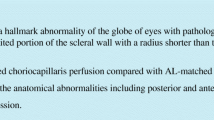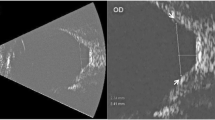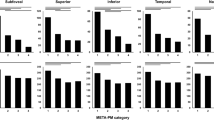Abstract
Purpose
Our aim was to highlight the presence and the frequency of posterior staphyloma (PS) in non-highly myopic retinitis pigmentosa (RP) patients and to study the relationship between PS and choroidal thickness (CT).
Methods
This was a retrospective case–control study of 77 eyes (39 patients) with RP, axial length inferior to 26 mm and clinically preserved macular area. All patients underwent fundus photography, A- and B-scan ocular ultrasonography, fundus autofluorescence (FAF) and swept source optical coherence tomography (SS-OCT). PS was defined by an outward bowing of the sclera on SS-OCT and B-scans. The relationship between the PS and SS-OCT layers thicknesses was determined.
Results
Over 77 RP eyes of 39 patients studied, a PS was identified in 17 eyes (22%) of nine patients. Fifteen eyes had a narrow macular staphyloma (NMS), and two eyes had a wide macular staphyloma (WMS). Mean age in this group was 34.2 years (range 19–53 years), mean axial length was 23.60 ± 0.61 mm and mean CT was 185.7 ± 71 um versus 259.7 um in eyes without PS. The staphyloma edges corresponded to area of outer retina loss on SS-OCT and were larger than the hyperautofluorescent ring on FAF.
We found a significant association between PS and CT in our RP patients (p = 0.003).
The mean CT was significantly thinner in PS eyes compared to eyes without staphyloma. There was no significant association between PS and with visual acuity, years of progression, retinal thickness nor FAF findings.
Conclusions
PS was present in 22% of non-highly myopic eyes with RP. Narrow macular staphyloma was the most common type observed in our series. A marked thinning of the choroid was noted in PS eyes when compared to RP eyes without PS, as well as the outer retina degeneration.




Similar content being viewed by others
References
Tsang SH, Sharma T (2018) Retinitis pigmentosa (non-syndromic). Adv Exp Med Biol 1085:125–130
Liu G, Liu X, Li H, Du Q, Wang F (2016) Optical coherence tomographic analysis of retina in retinitis pigmentosa patients. Ophthalmic Res 56(3):111–122
Xu X, Fang Y, Yokoi T et al (2019) Posterior staphylomas in eyes with retinitis pigmentosa without high myopia. Retina 39(7):1299–1304
Curtin BJ (1977) The posterior staphyloma of pathologic myopia. Trans Am Ophthalmol Soc 75:67–86
Ohno-Matsui K (2014) Proposed classification of posterior staphylomas based on analyses of eye shape by three-dimensional magnetic resonance imaging and wide-field fundus imaging. Ophthalmology 121(9):1798–1809
Spaide RF (2014) Staphyloma: part 1. Springer, New York
Ohno-Matsui K, Jonas JB (2019) Posterior staphyloma in pathologic myopia. Prog Retin Eye Res 70:99–109
Lezrek O, Daoudi C, Ez-Zahraoui M, Ben Dali I, Laghmari M (2017) Posterior staphyloma in a hyperopic eye. J Fr Ophthalmol 40(10):906–907
Scott A, Kashani S, Towler HM (2005) HM progressive myopia due to posterior staphyloma in Type I osteogenesis imperfecta. Int Ophthalmol 26(4–5):167–169
Ilhan A, Yolcu U, Diner O, Uzun S, Gundogan FC (2016) Coexistence of posterior staphyloma, retinitis pigmentosa and moderate myopia. J Coll Phys Surg Pak 26(1):70–71
Lee S, Schimmenti LA, King RA, Brilliant M, Anderson JL, Schoonveld C, Summers CG (2015) Posterior staphyloma in oculocutaneous albinism: another possible cause of reduced visual acuity. J AAPOS 19(6):562–564
Toma C, Ruberto G, Marzi F et al (2018) Macular staphyloma in patients affected by Joubert syndrome with retinal dystrophy: a new finding detected by SD-OCT. Doc Ophthalmol 137(1):25–36
Smirnov VM, Marks C, Drumare I, Defoort-Dhellemmes S, Dhaenens CM (2019) Severe retinitis pigmentosa with posterior staphyloma in a family with c.886C%3eA p. (Lys296Glu) RHO mutation. Ophthalmic Genet 22:1–4
Habibi I, Chebil A, Falfoul Y et al (2016) Identifying mutations in Tunisian families with retinal dystrophy. Sci Rep 22(6):37455
Komori S, Ueno S, Ito Y, Sayo A et al (2019) Steeper macular curvature in eyes with non-highly myopic retinitis pigmentosa. Invest Ophthalmol Vis Sci 60(8):3135–3141
Moriyama M, Ohno-Matsui K, Hayashi K, Shimada N, Tokoro T, Morita I (2011) Topographical analyses of shape of eyes with pathologic myopia by high-resolution three dimensional magnetic resonance imaging. Ophthalmology 118:1626–1637
Wang NK, Wu YM, Wang JP et al (2016) Clinical characteristics of posterior staphylomas in myopic eyes with axial length shorter than 26.5 millimeters. Am J Ophthalmol 162:180–190.e181
Jonas JB, Ohno-Matsui K, Jiang WJ, Panda-Jonas S (2017) Bruch membrane and the mechanism of myopization: a new theory. Retina 37(8):1428–1440
Ohno-Matsui K, Akiba M, Modegi T et al (2012) Association between shape of sclera and myopic retinochoroidal lesions in patients with pathologic myopia. Invest Ophthalmol Vis Sci 53:6046–6061
Jonas JB, Panda-Jonas S (2016) Secondary Bruch's membrane defects and scleral staphyloma in toxoplasmosis. Acta Ophthalmol 94:e664–e666
Fujiwara T, Imamura Y, Margolis R, Slakter JS, Spaide RF (2009) Enhanced depth imaging optical coherence tomography of the choroid in highly myopic eyes. Am J Ophthalmol 148:445450
Ikuno Y, Tano Y (2009) Retinal and choroidal biometry in highly myopic eyes with spectraldomain optical coherence tomography. Invest Ophthalmol Vis Sci 50:3876–3880
Smith EL, Hung LF, Huang J, Blasdel TL, Humbird TL, Bockhorst KH (2010) Effects of optical defocus on refractive development in monkeys: evidence for local, regionally selective mechanisms. Invest Ophthalmol Vis Sci 51:3864–3873
Makiyama Y, Ooto S, Hangai M et al (2013) Macular cone abnormalities in retinitis pigmentosa with preserved central vision using adaptive optics scanning laser ophthalmoscopy. PLoS ONE 8(11):e79447
Khan AO, Eisenberger T, Nagel-Wolfrum K, Wolfrum U, Bolz HJ (2015) C21orf2 is mutated in recessive early-onset retinal dystrophy with macular staphyloma and encodes a protein that localises to the photoreceptor primary cilium. Br J Ophthalmol 99(12):1725–1731
Michaelides M, Urquhart J, Holder GE, Restori M, Kayali N, Manson FD, Black GC (2006) Evidence of genetic heterogeneity in MRCS (Microcornea, rod-cone dystrophy, cataract, and posterior staphyloma) syndrome. Am J Ophthalmol 141(2):418–420
Kuniyoshi K, Sakuramoto H, Yoshitake K et al (2014) Longitudinal clinical course of three Japanese patients with leber congenital amaurosis/early-onset retinal dystrophy with RDH12 mutation. Doc Ophthalmol 128(3):219–228
Acknowledgements
The Tunisian Ministry of Public Health and the Ministry of Higher Education and Scientific Research (LR14 SP01) supported this work.
Funding
The author(s) received no financial support for the research, authorship and/or publication of this article.
Author information
Authors and Affiliations
Corresponding author
Ethics declarations
Conflict of interest
The author(s) declared no potential conflicts of interest with respect to the research, authorship and/or publication of this article.
Ethical approval
The Local Ethics Committee of the Hedi Rais Institute of Ophthalmology of Tunis, Tunisia, approved this work.
Additional information
Publisher's Note
Springer Nature remains neutral with regard to jurisdictional claims in published maps and institutional affiliations.
Rights and permissions
About this article
Cite this article
El Matri, L., Falfoul, Y., El Matri, K. et al. Posterior staphylomas in non-highly myopic eyes with retinitis pigmentosa. Int Ophthalmol 40, 2159–2168 (2020). https://doi.org/10.1007/s10792-020-01396-3
Received:
Accepted:
Published:
Issue Date:
DOI: https://doi.org/10.1007/s10792-020-01396-3




